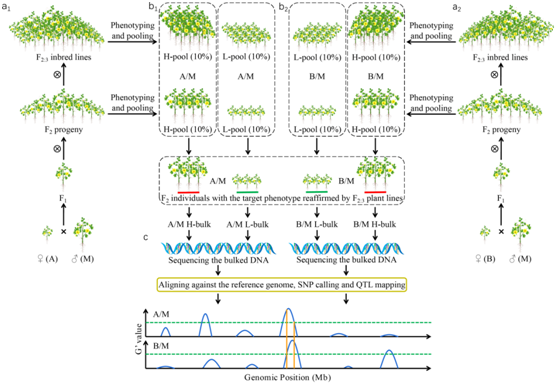- Location : Home» Newsroom
Increasing mapping resolution of stable QTLs by extending NGS-BSA
The bulked segregant analysis (BSA) combined with next-generation sequencing (NGS-BSA) allows rapid identification of genome sequence differencesresponsible for phenotypic variation. However, the application of NGS-BSA in crops generally uses an F2 segregating population whose high heterozygosity and single genetic background may hinder the QTLs mapping accuracy and application in crop improvement. Recently, researchers from the Institute of cotton research of CAAS reported thatthe Association Analysis of QTL-seq on Semi-homologous Populations (AAQSP) extended NGS-BSA with two (or more) semi-homologous populations, thus further improving the resolution and stability of QTLs mapping. This researchwas recently published in Theoretical and Applied Genetics.
In this study, researchers used the F2 and F2:3 populations to construct BSA bulks, which allows for addressing the heterosis influence on phenotypic assessment and achieving the efficacious segregation of pheno-related alleles between bulks. Then, researchers implemented NGS-BSA analysis on two (or more) semi-homologous F2 populations and defined overlapped intervals as the final selected QTLs, which allows for increasing the resolution of QTL mapping and isolating the stable QTLs from different genetic backgrounds. Compared with other NGS-BSA approaches, the cost-effectiveness of AAQSP procedure is higher due to the higher resolution and its ability to locate stable QTLs.
This study was supported by the National Natural Science Foundation of China (grant No. 32070560 and 31621005), the Natural Science Foundation of Xinjiang Uygur Autonomous Region (grant No.2021D01B114), China Agriculture Research System of MOF and MARA, and the Xinjiang Production and Construction Corps Innovation Program for Science and Technology Talents (grant No. 2020CB005). Ph.D. student Xiaoyu Wang and Prof. Youlu Yuan are the first author and corresponding author, respectively.
The article can be found:https://doi.org/10.1007/s00122-022-04181-1

Figure1. The scheme of AAQSP as applied to mapping QTLs for the plant height in cotton.